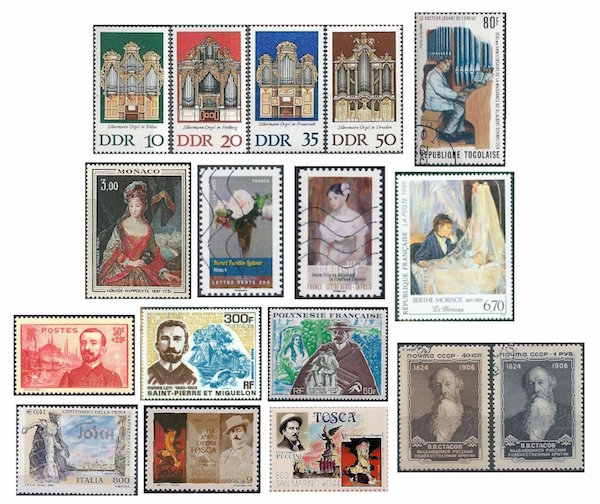The Arts on the Stamps of the World — January 14
An Arts Fuse regular feature: the arts on stamps of the world.

By Doug Briscoe
Our arts birthday subjects today include three French painters, an organist, an organ builder, a novelist, and a music critic. It’s also the 116th anniversary of the first performance of Puccini’s Tosca.
Gottfried Silbermann (14 January 1683 – 4 August 1753) and his brother Andreas (1678 – 1734) built dozens of pipe organs along with other keyboard instruments. There are 29 organs still existing in Saxony alone, including the two considered Silbermann’s greatest, the organs in the Hofkirche in Dresden (completed after his death; pictured at far right) and in Freiberg Cathedral (second from left). Frederick the Great purchased a number of Silbermann’s pianos, two of which can still be found in Frederick’s Potsdam palaces today. Silbermann also built harpsichords and clavichords; one was owned by CPE Bach, who composed a “Farewell to the Silbermann Keyboard” when he gave up the instrument in 1781. In 1976 East Germany issued this beautiful set of stamps showing four of the organs bult by Gottfried Silbermann.
Born exactly one year after Silbermann was French painter Jean-Baptiste van Loo (1684 – 19 December 1745), who came from a family of painters of Dutch origin. He was active in Rome, Paris, and London, returning to his birthplace of Aix-en-Provence toward the end of his life. His portrait of Princess Louise Hippolyte of Monaco was painted around 1730. The stamp was issued in 1972, not to honor Van Loo, but as part of a series of Monegasque princes.
Henri Fantin-Latour and Berthe Morisot were born precisely five years apart. Both painters are represented in a quite new series of French art stamps, Fantin-Latour (1836 – 25 August 1904) with one of his many studies of roses and Morisot (1841 – March 2, 1895) by her Jeune fille en décolleté, la fleur aux cheveux (1893). In addition, we see an earlier issue from 1995 of her work Le berceau (1872). Morisot’s work has also been issued on many colorful souvenir sheets (not shown) from African nations like Burundi, Djibouti, Ivory Coast, Mozambique, Sierra Leone, Somalia, and Togo, which earn considerable revenue from the sale of such items.
We may as well remain in France a while for novelist Pierre Loti (nom de plume of Louis Marie-Julien Viaud, born 1850), who had a distinguished career in the French navy. Following a visit to Istanbul he was persuaded by his officer colleagues to adapt his diary entries for publication, and this work appeared as the semiautobiographical novel Aziyadé (1879). Turkey made a deep impression upon Loti, and his enthusiasm for the country earned him the gratitude of the Turkish people despite his occasional criticisms; these were dismissed by the poet Nâzim Hikmet (whose birthday is tomorrow!) as constructive, a sympathetic expression of what Loti saw as the backwardness of the Ottoman Empire. Loti’s next book, Rarahu (1880), was the inspiration for Delibes’s 1883 opera Lakmé, and he went on to write a broad shelf’s worth of exotic novels. He died on 10 June 1923 and was honored on a French stamp as early as 1937.

Probably the most important 19th-century Russian music critic, so central to the careers of the major composers of the day, was Vladimir Vasilievich Stasov (14 January [O.S. 2 January] 1824 – 23 October [O.S. 10 October] 1906). As a firm believer in the notion of an independent Russian artistic endeavor freed from Western—and particularly German—influence, he became the mentor of a like-minded group and coined a name for them, the “Mighty Handful”: Balakirev, Rimsky-Korsakov, Mussorgsky, Borodin, and Cui. Although devoted to a purely Russian musical expression, he was not averse to the use of foreign inspiration for some projects. For example, he suggested to Tchaikovsky the subject of Shakespeare’s “Tempest” and to Berlioz an idea for a Manfred Symphony after Byron; Berlioz didn’t follow through, and Tchaikovsky eventually took up the idea instead. On his death in 1906, Glazunov composed an orchestral score, the Prelude “à la mémoire de Wladimir Stassoff,” Op. 85 #1.
The extraordinary life and accomplishments of Albert Schweitzer (1875 – 4 September 1965) found expression in medicine, philosophy, and other disciplines, and many countries have issued many stamps honoring him, but for our purposes I show just a single stamp with a musical theme. Besides playing the organ (coincidentally, he made some recordings in 1936 on an instrument built by Gottfried Silbermann’s brother Andreas), he was a scholarly interpreter and writer on music, as well as a rescuer and restorer of historic organs. Schweitzer’s noble, rich, and productive life deserves more attention than can be suggested here.
Puccini’s Tosca was given its première at the Teatro Costanzi in Rome on this date in 1900. Two Tosca stamps, one from Italy, the other from Uruguay, were issued in the centenary year 2000. One year earlier, San Marino had issued a whole sheet of composers and their operas, and Puccini appeared among them.
A graduate of the University of Massachusetts with a B.A. in English, Doug Briscoe worked in Boston classical music radio, at WCRB, WGBH, and WBUR, for about 25 years, beginning in 1977. He has the curious distinction of having succeeded Robert J. Lurtsema twice, first as host of WGBH’s weekday morning classical music program in 1993, then as host of the weekend program when Robert J.’s health failed in 2000. Doug also wrote liner notes for several of the late Gunther Schuller’s GM Recordings releases as well as program notes for the Boston Classical Orchestra. For the past few years he’s been posting a Facebook “blog” of classical music on stamps of the world, which has now been expanded to encompass all the arts for The Arts Fuse.
